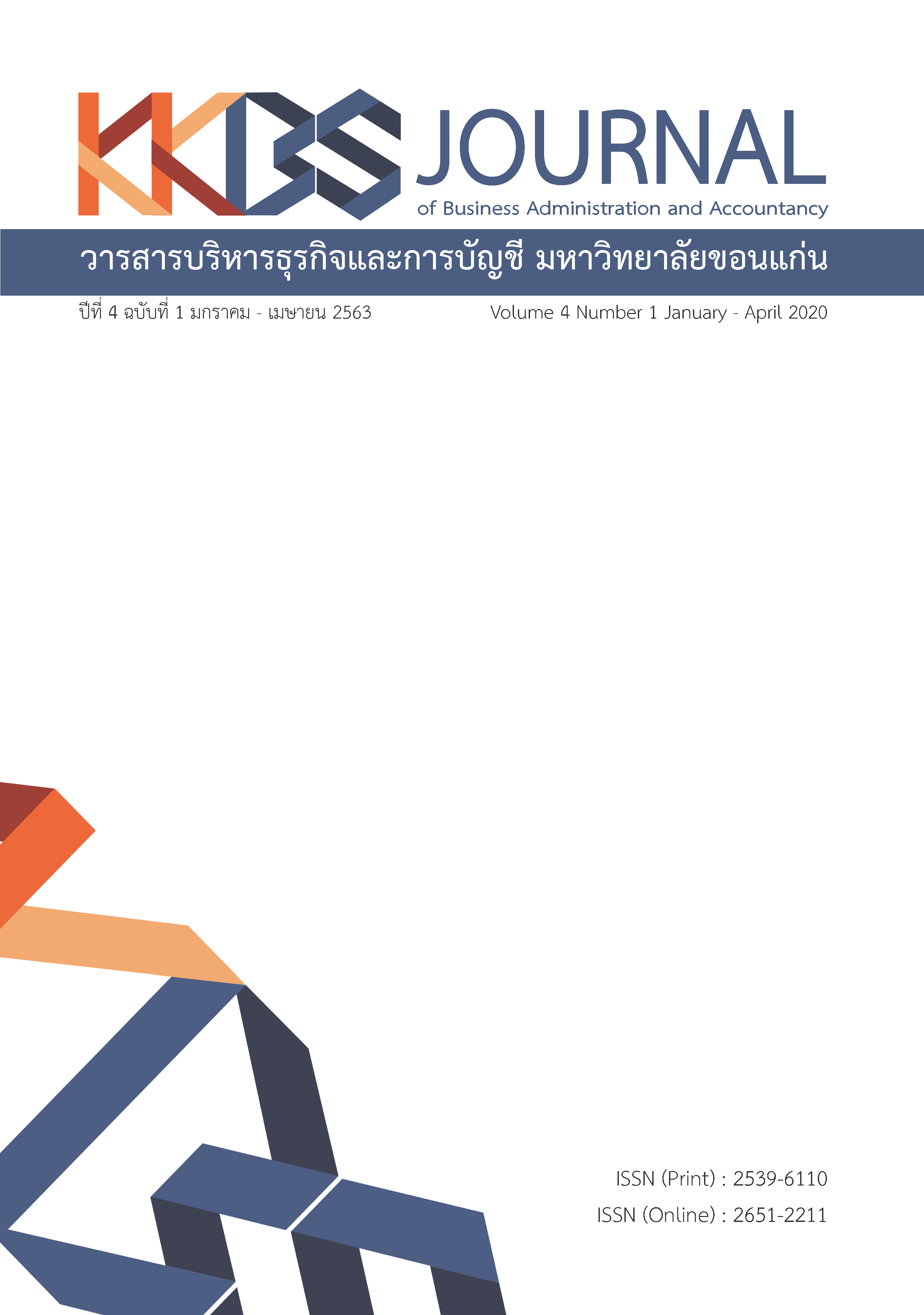การวิเคราะห์องค์ประกอบคุณภาพการให้บริการในธุรกิจเครื่องดื่มชานมไข่มุก ของเจนเนอเรชั่นวายในเขตกรุงเทพมหานคร
Main Article Content
บทคัดย่อ
งานวิจัยนี้มีวัตถุประสงค์ เพื่อวิเคราะห์องค์ประกอบคุณภาพการให้บริการของธุรกิจเครื่องดื่มชานมไข่มุกของเจนเนอเรชั่นวายในเขตกรุงเทพมหานคร โดยเป็นการวิจัยแบบเชิงปริมาณ ซึ่งมีกลุ่มตัวอย่างคือ ผู้บริโภคกลุ่มเจนเนอเรชั่นวายในเขตกรุงเทพมหานครที่ซื้อเครื่องดื่มชานมไข่มุก จำนวน 400 คน โดยมีแบบสอบถามเป็นเครื่องมือในการเก็บรวบรวมข้อมูล สถิติที่ใช้ในการวิเคราะห์ข้อมูลคือ ความถี่ ร้อยละ ค่าเฉลี่ยและการวิเคราะห์องค์ประกอบเชิงสำรวจ ผลการวิจัยพบว่า การวิเคราะห์องค์ประกอบเชิงสำรวจของตัวแปรที่นำมาใช้ศึกษา โดยการวิเคราะห์ ค่าสถิติไกเซอร์-ไมเยอร์-ออลคิน เท่ากับ 0.878 และผลการทดสอบสหสัมพันธ์ระหว่างตัวแปรโดยภาพรวม ได้ค่าเมทริกสหสัมพันธ์ที่มีนัยสำคัญ โดยค่าไค-สแควร์ เท่ากับ 34192.093 และค่าองศาอิสระ เท่ากับ 630 ทั้งนี้ สามารถจัดกลุ่มเข้าองค์ประกอบร่วมได้ 5 ปัจจัยคือ ด้านความบริสุทธิ์สะอาด ปราศจากมลทิน ด้านประสบการณ์ ด้านความคล่องแคล่วว่องไว ด้านการแก้ปัญหาอย่างทันท่วงที และด้านระดับการให้บริการ ตามลำดับ โดยสามารถอธิบายค่าความแปรปรวนได้ร้อยละ 78.62
Article Details
บทความที่ได้รับการตีพิมพ์ในวารสารเป็นความคิดเห็นของผู้เขียน มิใช่ความคิดเห็นของกองบรรณาธิการและคณะผู้จัดทำวารสาร และบทความที่ได้รับการตีพิมพ์เป็นลิขสิทธิ์ของวารสารบริหารธุรกิจและการบัญชี มหาวิทยาลัยขอนแก่น
เอกสารอ้างอิง
Brand Inside. (2019). Thai drink the highest cup of Bubble milk tea in ASEAN, averaging 6 glasses per month. Retrieved February 25, 2020, from https://brandinside.asia/thealley-pearl-milk-tea/ (in Thai)
Flimthii. (2019). Look at for 20 shop milk tea in Bangkok and try sticky pearls, definitely happy. Retrieved February 26, 2020, from https://travel.trueid.net/detail/LQ2ygk2vMY3 (in Thai)
Hair, J.F., Black, W.C., Babin, B.J. & Anderson, R.E. (2010). Multivariate data analysis. 7th ed. Upper Saddle River, N.J.: Prentice Hall.
Insight Gen Y. (2012). Phra siam, 2, 42-43. (in Thai)
Kaiser, H.F. & Rice, J. (1974). Little Jiffy, Mark IV. Educational and Psychological Measurement, 34(1), 111-117.
Longtunman. (2019). Longtunman 10.0. Bangkok: LTman. (in Thai)
Makynen, K. (2020). Bubble milk tea hides bad tapioca pearls. Retrieved February 25, 2020, from https://www.chula.ac.th/cuinside/26351/ (in Thai)
Moonsri, K., Seedee, R. & Chankoson, T. (2016). Service quality development guidelines of three-star hotel entrerpreneur in Thailand for Asean tourists. Rajabhat Chiang Mai Research Journal, 17(1), 19-32. (in Thai)
Panyarote, S. (2019). Service mind. Retrieved February 26, 2020, from https://www.gotoknow.org/posts/425881. (in Thai)
Parasuraman, A., Zeithaml, V.A. & Berry, L.L. (1990). Delivering quality service: Balancing customer perception. New York: Free Press.
Pipatphokakul, P. (2018). Service experience: competitive strategy. Retrieved Febuary 26, 2020, from http://www.impressionconsult.com/web/index.php/articles/157-service-experience.html. (in Thai)
Silpjaru, T. (2017). Research and statistical analysis with SPSS and AMOS. 17th ed. Bangkok: Business R&D. (in Thai)
Suthanthawibun, W. (2018). Specific Gen Y behavior. Retrieved February 26, 2020, from https://www.prachachat.net/finance/news-211619. (in Thai)
Thairath Online. (2018). Bubble tea fever! Bubble milk tea five market, the best-selling famous brand? Retrieved February 27, 2020, from https://www.thairath.co.th/scoop/1496493. (in Thai)
Thansettakij. (2017). Thailand generation Y’s largest and create an opportunity and risk behavior. Retrieved February 24, 2020, from http://www.thansettakij.com/content/234315. (in Thai)
TNN. (2019). Bubble milk tea unhealthy drinks that many people have to give up. Retrieved February 24, 2020, from https://today.line.me/TH/article/rMnM3j?utm_source=copyshare. (in Thai)


